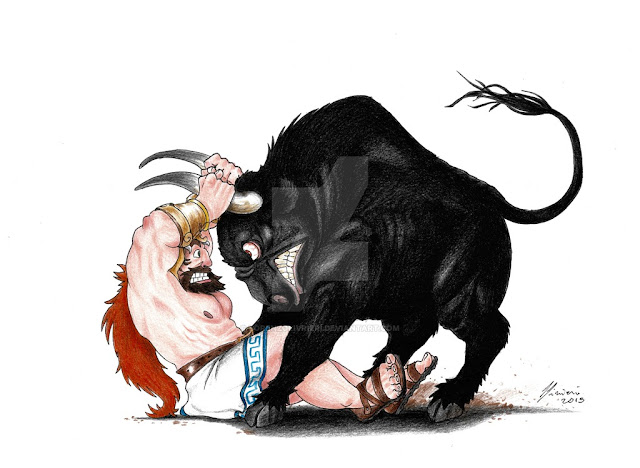EURYSTHEUS ordered Heracles, as his Seventh Labour, to capture the Cretan Bull; but it is much disputed whether this was the bull sent by Zeus, which ferried Europe across to Crete, or the one, withheld by Minos from sacrifice to Poseidon, which sired the Minotaur on Pasiphaë. At this time it was ravaging Crete, especially the region watered by the river Tethris, rooting up crops and levelling orchard walls.
b. When Heracles sailed to Crete, Minos offered him every assistance in his power, but he preferred to capture the bull single-handed, though it belched scorching flames. After a long struggle, he brought the monster across to Mycenae, where Eurystheus, dedicating it to Hera, set it free. Hera however, loathing a gift which redounded to Heracles’s glory, drove the bull first to Sparta, and then back through Arcadia and across the Isthmus to Attic Marathon, whence Theseus later dragged it to Athens as a sacrifice to Athene.
c. Nevertheless, many still deny the identity of the Cretan and Marathonian bulls.
1. The combat with a bull, or a man in bull’s disguise-one of the ritual tasks imposed on the candidate for kingship-also appears in the story of Theseus and the Minotaur, and of Jason and the fire-breathing bulls of Aeëtes. When the immortality implicit in the sacred kingship was eventually offered to every initiate of the Dionysian Mysteries, the capture of a bull and its dedication to Dionysus Plutodotes (‘giver of wealth’) became a common rite both in Arcadia (Pausanias) and Lydia (Strabo), where Dionysus held the title of Zeus. His principal theophany was as a bull, but he also appeared in the form of a lion and a serpent. Contact with the bull’s horn enabled the sacred king to fertilize the land in the name of the Moon-goddess by making rain-the magical explanation being that a bull’s bellow portended thunderstorms, which rhombi, or bull-roarers, were accordingly swung to induce. Torches were also flung to simulate lightning and came to suggest the bull’s fiery breath.
2. Dionysus is called Plutodotes (‘wealth-giver’) because of his cornucopia, torn from a bull, which was primarily a water charm; he developed from Cretan Zagreus, and among Zagreus’s changes are lion, a horned serpent, a bull, and ‘Cronus making rain’.
b. When Heracles sailed to Crete, Minos offered him every assistance in his power, but he preferred to capture the bull single-handed, though it belched scorching flames. After a long struggle, he brought the monster across to Mycenae, where Eurystheus, dedicating it to Hera, set it free. Hera however, loathing a gift which redounded to Heracles’s glory, drove the bull first to Sparta, and then back through Arcadia and across the Isthmus to Attic Marathon, whence Theseus later dragged it to Athens as a sacrifice to Athene.
c. Nevertheless, many still deny the identity of the Cretan and Marathonian bulls.
2. Dionysus is called Plutodotes (‘wealth-giver’) because of his cornucopia, torn from a bull, which was primarily a water charm; he developed from Cretan Zagreus, and among Zagreus’s changes are lion, a horned serpent, a bull, and ‘Cronus making rain’.

Comments
Post a Comment